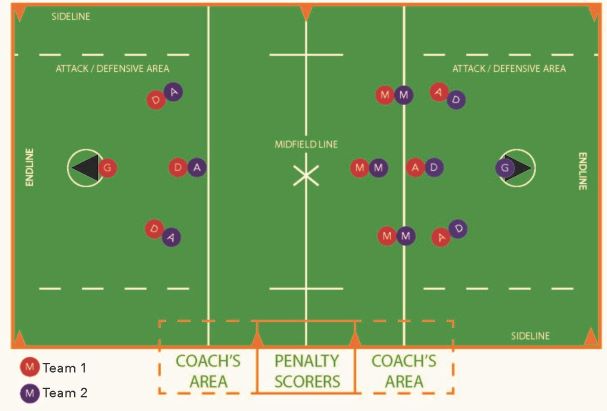About Lacrosse
Lacrosse is a field game played by two opposing teams, with a ball and a special netted stick, or crosse, with which the ball is caught, carried, and thrown. The game, originally played as training for warfare by the Native Americans of North America, and called baggataway, was adopted by the French-Canadians. They called the head of the stick used in the game la crosse because it resembles a bishop's crosier or cross. The National Lacrosse Association (now the Canadian Lacrosse Association) was formed in 1867 to govern the sport. Since then, lacrosse has, by reason of culture, tradition, and popularity, become the Canadian national game.

| Goalie | Similar to Soccer and Hockey goalies, lacrosse goalies stay in or near the net to defend against an opposing teams’ shots. |
| Defenders | Players who help guard their own goal from the opposing team. In Men's Lacrosse, defenders may use a lacrosse stick with a long pole. |
| Midfield | Players that help on offense and defence, and prevent opponents from trying to move from a defensive to an attacking /scoring position. |
| Attackers | Players whose job is to set up offense and take shots at the opponent’s goal, trying to score points. |
The Rules
Lacrosse teams include a goalkeeper, three attack players, three midfield players, and three defence players. The goalkeeper, like the other players, is equipped with a crosse, but may defend with hands and body as well. Substitutions are permissible. The uniforms commonly worn are jerseys and shorts and studded shoes, and protective equipment for the men includes helmets with steel wire face guards, light shoulder and arm padding, and gloves similar to those worn in ice hockey.
The object of lacrosse is to send the ball, using the crosse, through the goalposts of the opposing team. In general, the rules are as follows: Each goal counts 1 point, and the team scoring the most goals is the winner. If teams are tied at the end of the game, they play sudden-death overtime until a goal is scored.
The game is started by facing: in the men's game, two opposing players in the centre of the field, their backs to their own goals, hold their crosses on the ground, with the ball placed on the ground between them. At a signal from the referee, they draw their crosses towards themselves, the faster of the two picking up the ball. The women's game begins differently, with the ball held between the sticks of two opposing players. At the referee's signal, the players try to gain possession of the ball.
The ball is never touched with the hand, but caught, carried, and thrown with the crosse. It may be passed in any direction, backwards, forwards, or sideways. Long throws are allowed but seldom tried; the player usually runs with the ball until it can be passed to a nearby member of the team. A player may jar another player out of position or stop that player from running by a so-called body check, if the latter is about to receive the ball or is carrying it. A body check may not be made from behind, and players making the check must not hurl their bodies through the air, but must keep one foot on the ground. A player may also use the crosse to dislodge the ball from the crosse of an opponent. No physical contact is permitted in the women's game.
The ball is in play anywhere within the field, including the space behind the goals. If the ball is thrown out of bounds, or if a player in possession of the ball steps on or over a boundary, a free throw is given to an opposing player at that point. Play is started when the referee whistles. Free throws are not given within 20 yd (18 m) of either goal.
Technical fouls (minor infractions of the rules of the game) are punished by exclusion of the player from the game for 30 seconds, or by awarding a free throw to the opponent. Personal fouls, which are infractions of a more serious nature, such as tripping or pushing an opponent, an illegal body check, or unnecessary roughness, are punished by exclusion from the game for, from 1 to 3 minutes. The penalty for fouls in the women's game is a free position. Defenders start 3m behind the player with a free position. That player may then attempt a shot on goal or pass to a teammate.
Lacrosse Links
Lacrosse Victoria is the official organising body for the local competition. The site contains links to fixures and results. Rules and match day information used across all age groups are found here.
Lacrosse Australia is the national body with details of upcoming and previous national events.
Federation of International Lacrosse is the world governing body of lacrosse. The official FIL rules are available here. Local rules are an adaption/variation of these.
U.S. Lacrosse is the governing body in USA.
Purley Lacrosse Club
A very successful London based club where many of our Camberwell players have played.
Inside Lacrosse
Want to stay up to date with lacrosse in the US? This is the site.
Lacrosse Magazine
An excellent lacrosse magazine that posts to Australia.





